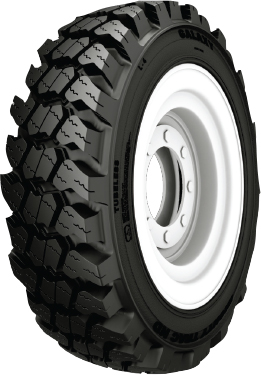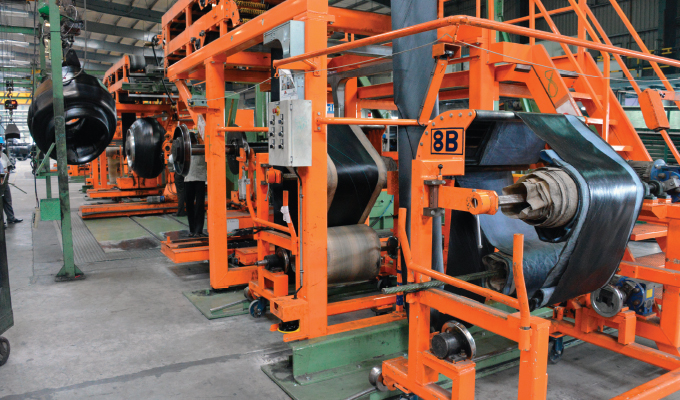By Ryan Lopes
Just like a building or a road—or any contracting job—the quality of a tire is a factor of good design, good materials, and good construction. And, just like the construction business, the tire industry benefits from constant innovation. Understanding the latest in tire technology can help you choose the best tires for your needs.
BREAKING THE PATTERN
The most noticeable thing about a tire is its tread pattern. The latest innovations in construction tire design tend to involve highly engineered block tread patterns. These new designs are a generation or two apart from the clunky blocks and lugs of older tires.
The innovation is often in the details—for example, the carefully developed ratio between rubber and the voids between the blocks. Yokohama Off-Highway Tires America, Inc. designed the Galaxy Mighty Trac ND with a rubber-to-void ratio of 52:48, an optimal balance between rubber on the ground and right-sized grooves to break up and evacuate mud.
ND, or non-directional, patterns enhance ride, fuel efficiency, and tire life because the tread works equally well in forward and reverse.
SMALL SIPES, BIG EFFECTS
Sipes are another subtle but important design feature. If you live in a cold climate, the snow tires on your truck are probably slit with thousands of tiny sipes for added traction in snow and ice. We have found that a few dozen larger sipes on construction tires add more biting edge area, significantly improving traction not just in snow but also on wet surfaces, mud, and dirt. We have also seen that sipes allow sturdy tread blocks to flex, providing more contact with the surface and improving traction even on dry ground.

GET A GRIP
You can’t see them, but the wire bead bundles that hold your tire to the rim are the product of extensive engineering—and they are not all created equal. A low-quality bead will allow your tire to slip on the rim under high torque. That’s a waste of horsepower, a limit on your machine’s productivity, and a lot of friction that can ultimately damage the tire.
Over the years, many tire manufacturers have learned to create hexagonal bead bundles for a firmer grip on the rim. Where torque is extreme and the design allows it—like the Galaxy LHD 510 Severe Duty Solid (SDS) loader tire for scrap yards and other punishing conditions—Yokohama Off-Highway Tires America, Inc. installs steel wire creel beads across the entire width of the rim, essentially eliminating slippage. That is a significant improvement over the two to four bead bundles most solid tires rely on.
QUALITY MATERIALS
Most people call it “rubber,” but a tire is actually made of dozens of ingredients combined in secret formulas called compounds. Synthetic and natural rubber are just two of the components of each compound, which are carefully balanced to provide the ideal mix of durability and flexibility, wear resistance and cut resistance, grip and hardness.
Ask your tire dealer how different tires perform on the surfaces you tend to run your equipment on. For a skid steer on paved surfaces, you’ll want a harder tread compound that resists scrubbing. For a backhoe on rock and broken concrete, a softer, cut-resistant compound would last longer.
With all that complexity, it’s no surprise that compound technology is the most closely guarded secret in most tire companies. Yokohama Off-Highway Tires has more than 100 years of innovative history in tire compounding chemistry.
GOOD MAINTENANCE
Like any tool, a tire must be maintained properly to deliver the performance and service life it was designed to provide. At the start of every shift, operators should take a moment to walk around their machines, checking tires for damage or hazards. Debris in the bead area can dislodge the tire from the rim. A rock jammed in the tread can hammer away at the tire until the undertread plies rupture.
But the most destructive—and invisible—threat to a tire is improper inflation pressure. The air inside your tire is what carries the weight of the machine and its payload. Too much air and the tire will crown, creating a high spot in the middle of the tread that reduces traction, accelerates wear, and is prone to impact damage.
Too little air is even worse: excessive flexing of the sidewall builds up heat that can melt the compounds and cause belts, plies, and other components of the tire to separate. The result can be catastrophic … and completely avoidable. That’s why we say a $5 pressure gauge can protect thousands of dollars’ worth of tires.
CLOSING THOUGHT
In all, a construction tire is an investment, a precision tool that can help your equipment perform its best and make your crew more productive. And as with any tool, a little time taken up front to choose the right product and a few minutes a day spent making sure it’s properly maintained will help keep it working for you hour after hour, job after job.
About the author:
Ryan Lopes is national product manager–materials handling and solid tires for Yokohama Off-Highway Tires America, Inc. An engineer and MBA, Ryan has worked in manufacturing and marketing in both industrial machinery and tires.
Modern Contractor Solutions, March 2021
Did you enjoy this article?
Subscribe to the FREE Digital Edition of Modern Contractor Solutions magazine.



